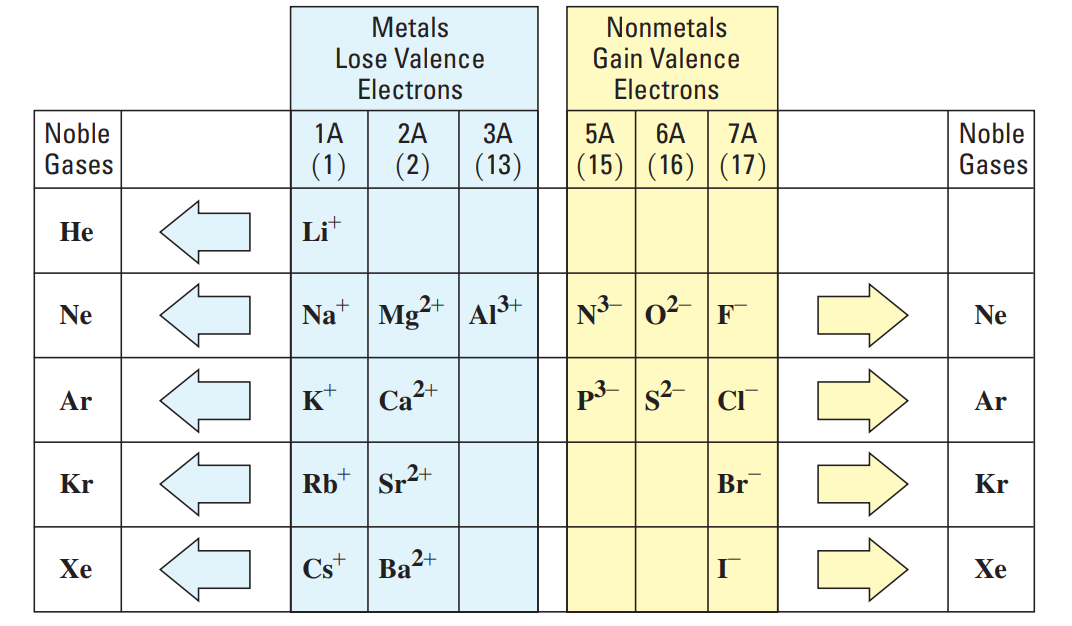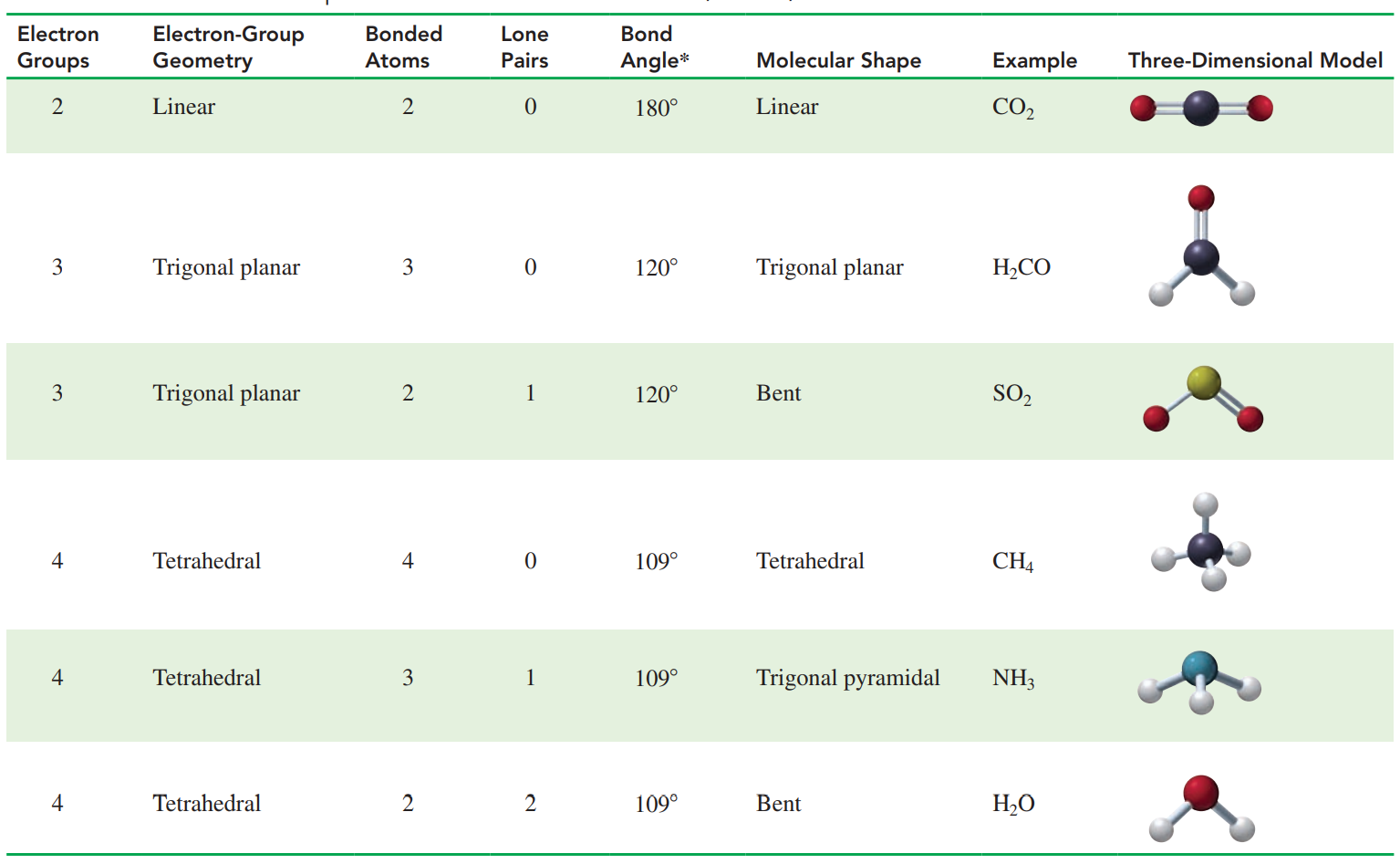Chapter 6: Ionic and Molecular Compounds
6.1: Ions: Transfer of Electrons
- Most of the elements, except the noble gases, are found in nature combined as compounds.
- One explanation for the stability of noble gases is that they have a filled valence electron energy level.
- In the formation of either an ionic bond or a covalent bond, atoms lose, gain, or share valence electrons to acquire an octet of eight valence electrons.
- Octet Rule: The tendency of atoms to attain a stable electron arrangement provides a key to our understanding of the ways in which atoms bond and form compounds.
- Ionic Bonds: Occurs when the valence electrons of atoms of a metal are transferred to atoms of nonmetals.
- Covalent Bonds: Occurs when atoms of nonmetals share valence electrons.
Positive Ions
- Positive Ions: The loss of electrons.
- In ionic bonding, ions form when atoms lose or gain electrons to form a stable electron arrangement.
- Ionic Charge: A positive electrical charge.
- Cations: Positively charged ions.
Negative Ions
- Negative Ions: The gain of electrons.
- In an ionic compound, a nonmetal atom gains one or more valence electrons to obtain a stable electron configuration.
- Anion: A negatively charged ion.
Ionic Charges from Group Numbers
The elements in Group 1A lose one electron to form ions with a 1+ charge.
The elements in Group 2A lose two electrons to form ions with a 2+ charge.
The elements in Group 3A lose three electrons to form ions with a 3+ charge.
The elements in Group 7A gain one electron to form ions with a 1– charge.
The elements in Group 6A gain two electrons to form ions with a 2– charge.
The elements in Group 5A gain three electrons to form ions with a 3– charge.
The nonmetals of Group 4A 1142 do not typically form ions.
- The metals Sn and Pb in Group 4A lose electrons to form positive ions.

6.2: Ionic Compounds
- Ionic compounds consist of positive and negative ions.
- Ionic Bonds: The ions are held together by strong electrical attractions between the oppositely charged ions.
- The positive ions are formed by metals losing electrons, and the negative ions are formed when nonmetals gain electrons.
- The chemical formula of a compound represents the symbols and subscripts in the lowest whole-number ratio of the atoms or ions.
- The subscripts in the formula of an ionic compound represent the number of positive and negative ions that give an overall charge of zero.
- Formula Unit: The lowest ratio of the ions in an ionic compound.
6.3: Naming Ionic Compounds
- In the name of an ionic compound made up of two elements, the name of the metal ion, which is written first, is the same as its element name.
- The name of the nonmetal ion is obtained by using the first syllable of its element name followed by –ide.
- Examples: Potassium iodide, Magnesium bromide & Aluminum oxide
6.4: Polyatomic Ions
- Polyatomic ion: A group of covalently bonded atoms that has an overall ionic charge.
- Most polyatomic ions consist of a nonmetal such as phosphorus, sulfur, carbon, or nitrogen covalently bonded to oxygen atoms.
- The names of the most common polyatomic ions end in –ate, such as nitrate and sulfate.
- When a related ion has one less oxygen atom, the –ite ending is used for its names such as nitrite and sulfite.
- Note that both the –ate ion and –ite ion of a particular nonmetal have the same ionic charge.
6.5: Molecular Compounds: Sharing Electrons
- Molecular Compound: It contains two or more nonmetals that form covalent bonds.
- When atoms share electrons, the bond is a covalent bond.
- When two or more atoms share electrons, they form a molecule.
- Lewis Structure
- The shared electrons, or bonding pairs, are shown as two dots or a single line between atoms.
- The nonbonding pairs of electrons, or lone pairs, are placed on the outside.
- Double Bond: It occurs when two pairs of electrons are shared.
- Triple Bond: It occurs when three pairs of electors are shared.
- Double and triple bonds form when the number of valence electrons is not enough to complete the octets of all the atoms in the molecule.
6.6: Electronegativity and Bond Polarity
- The electronegativity of an atom is its ability to attract the shared electrons in a chemical bond.
- Nonmetals have higher electronegativities than metals because nonmetals have a greater attraction for electrons than metals.
- Fluorine (F) has the highest electronegativity which has a value of 4.0.
- Metal Cesium (Cs) has the lowest electronegativity which has a value of 0.7.
- The noble gases have no electronegativity values because they do not typically form bonds.
- Nonpolar Covalent Bonds: A bond between atoms with identical or very similar electronegativity values.
- Polar Covalent Bond: Occurs when bonds are between atoms with different electronegativity values, and the electrons are shared unequally.
- Dipole: A polar covalent bond that has a separation of charges.
6.7: Shapes and Polarity of Molecules
- Valence shell electron-pair repulsion (VSEPR) theory: The electron groups are arranged as far apart as possible around the central atom to minimize the repulsion between their negative charges.
- According to VSEPR theory, minimal repulsion occurs when two electron groups are on opposite sides of the central Carbon (C) atom.
- This gives the Carbon Dioxide (CO2) molecule a linear electron-group geometry and a linear shape with a bond angle of 180°.
- Minimal repulsion occurs when three electron groups are as far apart as possible around the central C atom, which gives 120° bond angles.
- This type of electron-group geometry is trigonal planar.
- When there are four atoms attached to four electron groups, the shape of the molecule is tetrahedral.
Molecular Shapes for a Central Atom with Two, Three, and Four Bonded Atoms

Polarity of Molecules
- Nonpolar Molecule
- All the bonds are nonpolar or the polar bonds cancel each other out.
- It also occurs when polar bonds cancel each other because they are in a symmetrical arrangement.
- Polar Molecules
- One end of the molecule is more negatively charged than the other end.
- It occurs when the dipoles from the individual polar bonds do not cancel each other.
6.8: Attractive Forces in Compounds
- Dipole-Dipole Attractions: These are attractive forces that occur between the positive end of one molecule and the negative end of another.
- Hydrogen Bonds: These occur between the partially positive hydrogen atom in one molecule and the partially negative nitrogen, oxygen, or fluorine atom in another molecule.
- Polar molecules containing hydrogen atoms bonded to highly electronegative atoms of nitrogen, oxygen, or fluorine form especially strong dipole–dipole attractions.
- Dispersion Forces: These are very weak attractions that occur between nonpolar molecules.
- The electrons in a nonpolar covalent molecule are distributed symmetrically.
- Electrons may accumulate more in one part of the molecule than another, which forms a temporary dipole.